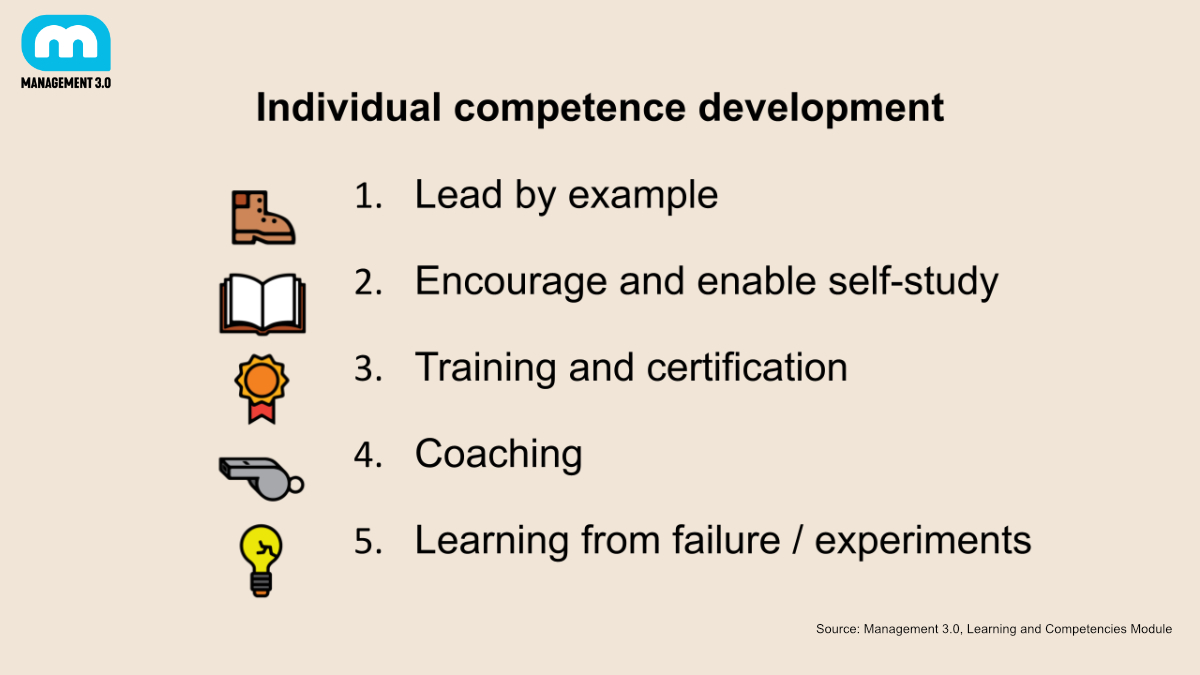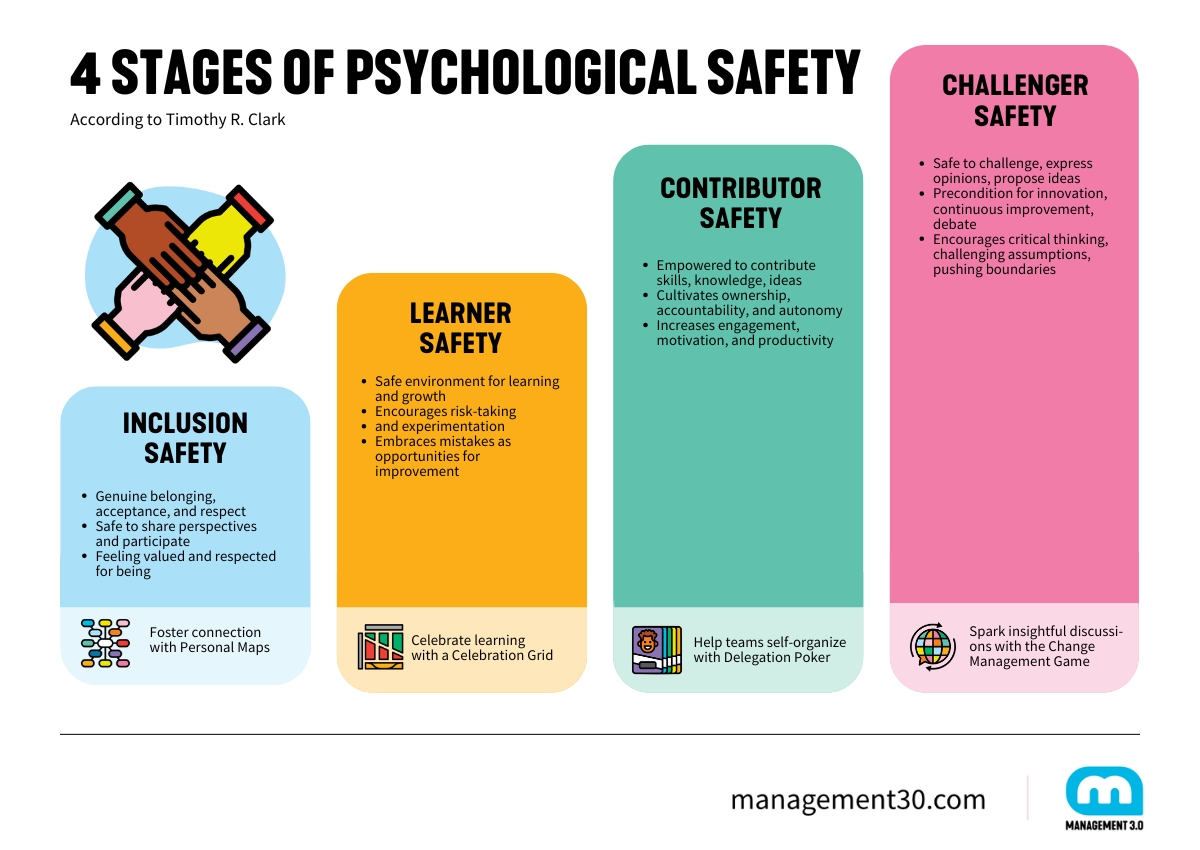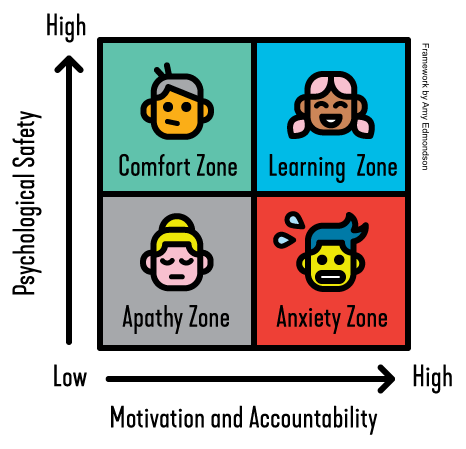by Voranc Kutnik, Management 3.0 facilitator and agile enthusiast. With a passion for teamwork, Voranc guides teams in embracing agile values, fostering innovation, and delivering exceptional products. Additionally, as a Certified Fearless Organization Practitioner, he possesses expertise in cultivating psychological safety within teams, a topic he delves into in the article, introducing the four stages of psychological safety.
Organizations worldwide are searching for ways to become more agile and responsive to change to survive today’s rapidly changing business environment. They want to develop new products and services as fast as possible. To achieve that, they must foster an innovative culture that encourages employees to think outside the box and generate new ideas.
The Importance of Teams
However, more than motivated and creative individuals are needed to solve all the challenging problems and develop products that will succeed in the crowded market. In today’s world, innovation predominantly involves collaboration rather than individual efforts. Teams tackle complex challenges much more effectively than solitary geniuses. Therefore, organizations require more than just competent and hardworking individuals; they need highly productive teams.
As a team coach and organizational development consultant with over a decade of experience, I work with teams almost daily, which is the most enjoyable part of my work. It took me many years to accept that every team is unique and that there is no single recipe for helping it reach its full potential. Many factors define a team’s uniqueness and performance; the diversity of team members, the leadership style, the company culture, and the environment are some of them. All these factors are important, but the most crucial is the group-level phenomenon called psychological safety.
Psychological Safety
Psychological safety in the workplace is about employees feeling secure speaking up, sharing ideas, and challenging the status quo without fearing negative consequences. It’s an important concept in organizational psychology. Every team has its own level of psychological safety, defined by the norms and unwritten rules of teammates’ communication and collaboration.
Think of it like this: Would you be more likely to share a bold idea in a meeting where you felt judged or one where you felt supported? The answer is obvious.
Psychological safety is an emergent property of a group, not a personality difference.
Amy Edmondson
My colleague André already shared what psychological safety is, why it is important, and how it can be built. Check the article How can we build psychological safety to achieve more together? For today, I want to dive into something else, the so-called psychological safety stages.
There are many ways to measure the level of psychological safety in teams. Most of them are based on the seven statements defined by Amy Edmondson; each team member anonymously answers to what extent they agree or disagree with every statement. Amy Edmondson’s Fearless Organization Scan team survey is one such option and is my preferred measurement tool when I discuss the topic of psychological safety with teams.
Four Stages of Psychological Safety
In addition, we have a different viewpoint on the team’s psychological safety level. It is called The Four Stages of Psychological Safety. Timothy R. Clark wrote a great book on this topic: The Four Stages of Psychological Safety: Defining the Path to Inclusion and Innovation.
Understanding these stages is essential for leaders and managers to unlock the full potential of their teams and individuals. The goal is to help the team reach the fourth stage, where a leader sets clear expectations, and people get a license to challenge. The final stage is less comfortable for all than the previous ones because people make more observations about how the work is done in the team. And, of course, that includes comments about how the leader is doing his job.
Timothy R. Clark defined the four stages of psychological safety as Inclusion Safety, Learner Safety, Contributor Safety, and Challenger Safety. Each stage represents a higher level of psychological safety and team performance, with the Challenger Safety stage being the most advanced and productive.
I’ll explain the stages below. While reading, imagine an average working day with your primary team. What is the team’s culture, the norms and unwritten rules, how do you communicate and collaborate, and how is it with empathy?
Stage 1: Inclusion Safety
Inclusion Safety is the foundation stage of psychological safety. It centers on fostering an environment where all individuals feel genuine belonging, acceptance, and respect. In this stage, everyone feels safe to be themselves, share their perspectives, and participate without fear of negative repercussions. Inclusion safety is not just about being physically present in the team; it’s about feeling valued and respected for who you are and what you bring to the team.
Inclusion Safety is not earned but owned. It’s every person’s non-negotiable right. To qualify for inclusion safety, a person must meet two criteria: to be human and harmless. If an individual satisfies both requirements, they qualify for inclusion. If they meet only one, they do not. So, if there is no threat of harm, a person should be included.
It’s important to remember that diversity is a fact, but inclusion is a choice. Many organizations have made progress in creating diverse workforces but often need to improve in fostering inclusion. They may talk about inclusion, but they need to put it into practice. Creating an inclusive environment is not difficult – it simply involves treating people respectfully and understanding their individuality.
Establishing Inclusion Safety creates a foundation for the other stages of psychological safety to develop. Individuals are more likely to feel safe learning, contributing, and challenging the status quo when they know they are accepted and respected for who they are.
Stage 1 out of Four Stages of Psychological Safety: Inclusion Safety
- Genuine belonging, acceptance, and respect
- Safe to share perspectives and participate
- Feeling valued and respected for being
- Foster connection with Personal Maps
Stage 2: Learner Safety
Learner Safety is the next step in building psychological safety. It focuses on creating an environment where individuals feel safe to learn, grow, and make mistakes without fear of embarrassment or punishment. In this stage, people are encouraged to take risks, experiment, and ask questions, knowing they will be supported in their learning journey.
Learner Safety is about creating a culture of continuous learning and improvement, where mistakes are seen as opportunities for growth and innovation. It’s about fostering a mindset of curiosity and a willingness to learn from each other.
I have yet to see learner safety where inclusion safety is absent.
Timothy Clark
Individuals are more likely to take risks and try new things when they know they will be supported in their learning process, even if they fail initially. This can lead to breakthroughs and new discoveries that would not have been possible otherwise, fostering personal growth and development.
Leaders can’t just demand learning in their workplace; they inspire it by actively creating a supportive and encouraging environment. They must take the first step, giving the employees not just permission but also encouragement to engage in the learning process fully. In return, the employees should engage in the learning process. Yes, the employees must take responsibility and do their part to learn how to ensure safety.

Stage 2 out of Four Stages of Psychological Safety: Learner Safety
- Safe environment for learning and growth
- Encourages risk-taking and experimentation
- Embraces mistakes as opportunities for improvement
- Celebrate learning with a Celebration Grid
Stage 3: Contributor Safety
Contributor Safety builds upon the previous stages by creating an environment where individuals are not just safe but empowered to actively contribute their skills, knowledge, and ideas to the team’s goals. It involves cultivating a sense of ownership and empowerment, where everyone’s input is not just heard but also valued and respected.
An essential characteristic of this stage is that the individual gains autonomy, but in return, they become accountable for their performance. In the previous stage, they gained new knowledge and skills; now, it’s time to demonstrate reliability and deliver good results. The only way to get even more autonomy is with better performance.
When Contributor Safety is established, it creates a high-performing team where everyone is engaged and motivated to give their best. This can lead to increased productivity, innovation, and overall success.
Individuals are more likely to feel invested in the team’s goals when they know their contributions are valued and when they have a voice in decision-making.
Stage 3 out of Four Stages of Psychological Safety: Contributor Safety
- Empowered to contribute skills, knowledge, ideas
- Cultivates ownership, accountability, and autonomy
- Increases engagement, motivation, and productivity
- Help the team self-organize with Delegation Poker
Stage 4: Challenger Safety
Challenger Safety represents the highest level of psychological safety. It’s the stage where individuals feel safe challenging the status quo, expressing their honest opinions, and proposing new ideas without fear of punishment or negative consequences. This stage is a precondition for innovation, continuous improvement, and healthy debate within a team or organization. Individuals are encouraged to think critically, challenge assumptions, and push boundaries.
Challenger Safety democratizes innovation.
Timothy Clark
In this stage, a person gets permission to challenge the status quo in good faith. In other words, the person can be candid and blunt as far as they have good intentions and want to improve the current situation.
Timothy Clark advises leaders to give every team member the duty to disagree and then brace themselves to hear the truth, even if someone contradicts leadership.
Stage 4 out of Four Stages of Psychological Safety: Challenger Safety
- Safe to challenge, express opinions, propose ideas
- Precondition for innovation, continuous improvement, debate
- Encourages critical thinking, challenging assumptions, pushing boundaries
- Spark insightful discussions with the Change Management Game
Conclusion
These four stages are cumulative, meaning that employees must feel safe at each previous stage before progressing to the next. For example, employees need to feel included and respected before they will feel safe taking risks. And they need to feel safe taking risks before they will feel safe sharing their ideas and opinions.

Psychological safety isn’t just a nice-to-have; it’s a must-have for any team that wants to thrive in today’s competitive landscape. By investing in psychological safety, leaders are not just building a team; they’re building a culture of innovation and success.
As a leader or manager, I encourage you to assess your team’s psychological safety stage and to identify areas for improvement. This self-reflection and action can be the first step toward fostering a more productive and innovative team environment.
Sources:


